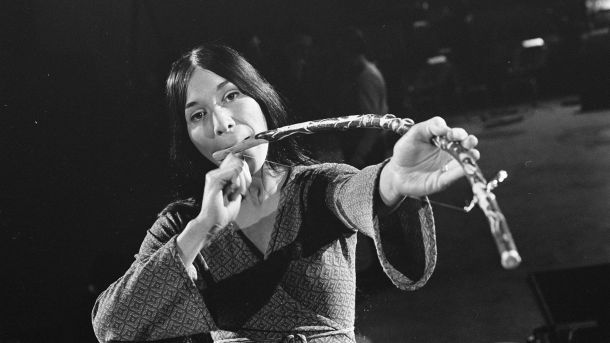Writer Alex Frank on how Buffy Sainte-Marie’s groundbreaking electronic album, “Illuminations,” upended expectations for the Indigenous folk star.
For musicians of the 1960s, there was what seems an insatiable creative struggle to break free from the image and idea of how they were first presented to the world. The Beatles left behind the moptops and pop songs to drop acid in India; Bob Dylan and Joni Mitchell bristled at the limits of acoustic folk by incorporating elements of rock, country, and jazz into their work, risking album sales, radio play, and, in one infamous case relating to Dylan, Pete Seeger’s hatchet at the Newport Folk Festival. The decade started with “She Loves You” and innocent calls for world peace sung in black and white on “Ed Sullivan,” and ended up somewhere far muddier, a land where politics mostly withered and psychedelic drugs bloomed, and it was the artists who led us there, or at the very least embodied the journey.
No musician more thrillingly upended expectations than Buffy Sainte-Marie, the Cree singer-songwriter who came into her own alongside Mitchell in the Greenwich Village folk scene, though, unlike many, she didn’t have to take LSD or entirely dispense with political causes to get there. She rose to prominence in the early ’60s with protest songs like “Universal Soldier,” as well as ones that addressed issues afflicting the Indigenous, the poor, the rural, and the rundown. She became an unlikely star singing unlikely hits, named Billboard’s Best New Artist of 1964. She was both entirely unique — one of the first and still only major Indigenous stars in pop culture, a woman who crafted haunting, idiosyncratic melodies and played the mouth bow — and yet also felt, even in the early days, that she was already being calcified by the media glare into something easily understandable and quaint, or in her words, “Pocahontas with a guitar.”
By the tail end of the ’60s, she’d end up taking a true left turn in her own artistry, one so complete that it forever changed the trajectory of her career and, as it turns out, of music at large. Right before the decade’s end, she released one of the most mysterious, inventive and influential albums of the era, one that continues to resonate today: 1969’s “Illuminations,” a whirlwind trip of eerie torch songs on which Buffy utilized new technology like the Buchla synth and quadraphonic audio to completely shatter sound and stitch it back together. “I didn’t want to sound like Joan Baez. I was always trying to cover the base that nobody else was covering. Because it needed to be covered,” she told me in 2017.
“Illuminations” is a tricky album to talk about, a glittering gemstone that seems to change color and luster as the light hits it from different vantage points.
It is, quite simply, a marvel, one I’ll never forget hearing for the first time. From groovy rock songs that sound like they were strummed with guitars set on fire, to quiet but grave incantations on magic and God, to more straightforward and pretty acoustic numbers about love and strolling through Paris, each successive song is a surprise, something you could never have expected to hear, all of them special and beautiful in their own rare way. “The Dream Tree” sounds like heaven, “He’s the Keeper of the Fire” sounds like Hades, and “Suffer the Little Children” is grounded in the injustices happening right here on planet earth, with Buffy finding a way to address societal issues even on an album that mostly seems to transcend worldly affairs. Then, there’s the spectral “Poppies,” which closes the record and is about as ghostly a song as can be imagined, something that strikes the listener as supernatural and almost sci-fi.
From a sonic point of view, there was really nothing else out there like it. While Dylan and his ilk were shedding the trappings of superstardom by going country and infusing old school Nashville twang into their music, Buffy was looking to the fertile future: electronic music was just starting to emerge, with trailblazers like Wendy Carlos — who helped develop and popularize the first commercial synthesizer, the Moog, featured on her own surprise hit 1968 album “Switched-On Bach” — leading the way. On “Illuminations,” Buffy experimented with the Buchla synthesizer[1], which had been invented in 1966; the first sound you hear on the album is her singing voice filtered through the synth, which makes her words sound almost like a frog croak echoing through a cave. “I just wanted to do something different, and using a Buchla synth, just doing my songs in a new way without regard at all to radio play — which we didn’t get any of [laughs] — that was kind of typical to me,” she said to me in another interview from 2015. “I’m curious and interested in sound.”
Of course, like most art this ahead of its time, the album wasn’t much of a commercial success. But it’s had a second life over the years, something people point to as a pivotal piece of work in the history of electronic, gothic, indie, and just downright weird music. Afterwards, Buffy herself continued to reinvent, always seeking out uncharted artistic territory. In the 1970s, she became a regular guest on “Sesame Street,” becoming the first woman to ever breastfeed her child on television on a 1977 episode. In the 1980s, she was one of the first artists to use early Apple and Macintosh computers to record music; in 1992, working from her home in Hawaii with a producer in the UK, she was quite possibly the first musician to make an album by sending audio files back and forth on the then-nascent internet. In 1983, she became the first Indigenous person to win an Oscar, for her song “Up Where We Belong,” which she co-wrote for the film “An Officer and a Gentleman.” And she continues to make fascinating, singular music: a 2015 album “Power in the Blood,” recorded in her 70s, snagged her the prestigious Canadian Polaris Music Prize.
You can feel spiritual, if subconscious, reverberations from “Illuminations” everywhere in contemporary music, with figures like Billie Eilish, Grimes, and Bjork just the latest brave artists who use electronic sounds to push at what’s possible.
In a larger sense, the drive towards reinvention has also been a defining characteristic of the last 60 years in music, in no small part because of artists like Buffy who made exploration and growth hallmarks of a vital career. We take it for granted, but innovation doesn’t have to be the aim; Beyoncé could release “Crazy in Love”s for the next 20 years, and we’d probably sop them up, but she chooses to change, to evolve, to try. Buffy, it would seem, was an artist born to do just that, a hugely consequential figure who challenged herself and stretched the boundaries of her own creativity. In this sense, there may be no consummate Buffy album — every single one is different than the one before — but if any could be said to be so, it would have to be “Illuminations,” an album of strange delights and, most importantly, satisfying surprises.
[1] Editors note: The buchla is a type of synthesizer manufactured in 1963 by Don Buchla, which revolutionized the way electronic music and sound is made.
[Editor’s Note – November 3, 2023: Recent investigative reports have sought to raise questions about Buffy Sainte-Marie’s Indigenous heritage. Sainte-Marie has stated that she is uncertain of her biological heritage and affirms her formal adoption into and identification with the Cree nation.]
























